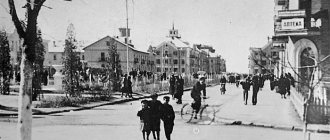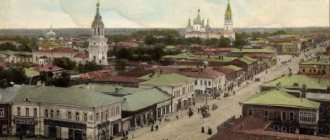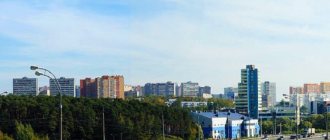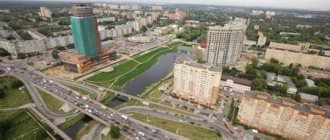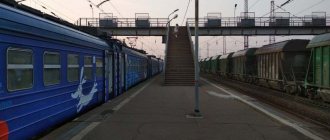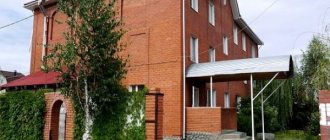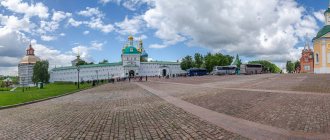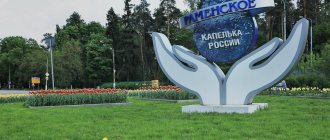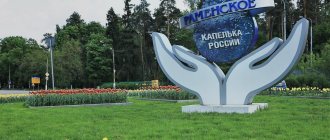City in Moscow region, Russia
| Cuban Cuban | |
| Town[1] | |
| Flag Coat of arms | |
| Location of Kubinka | |
| Cuban Location of Kubinka Show map of Russia Cuban Kubinka (Moscow region) Show map of the Moscow region | |
| Coordinates: 55°34′N 36°42'E / 55.567°N W. 36.700 ° E. / 55.567; 36.700Coordinates: 55°34′N 36°42'E / 55.567°N W. 36.700 ° E. / 55.567; 36.700 | |
| A country | Russia |
| Federal subject | Moscow region[1] |
| Administrative region | Odintsovo district[1] |
| Town | Cuban[1] |
| Based | 15th century |
| City status from | 2004 |
| Government | |
| • Mayor[2] | Pavel Stanislavovich Zdradovsky[2] |
| Square | |
| • General | 4 km2 (2 sq mi) |
| Height | 200 m (700 ft) |
| population (2010 Census)[3] | |
| • General | 22,964 |
| • Evaluate (2018)[4] | 20,157 (-12.2%) |
| • Density | 5,700/km2 (15,000/sq mi) |
| Administrative status | |
| • Capital from | Cuban[1] |
| Municipal status | |
| • Municipal district | Odintsovo municipal district[5] |
| • Urban village | Kubinka urban settlement[5] |
| • Capital from | Kubinka urban settlement[5] |
| Timezone | UTC + 3 (MSK [6]) |
| Postal code(s)[7] | 143070–143072 |
| Dial code(s) | +7 49869 |
| OKTMO I WOULD | 46641110001 |
| Day of the city | August 22 |
| Web site | www.kubinka-info.RU |
Cuban
(Russian: Kubinka) is a town in Odintsovo District of Moscow Oblast, Russia, located on the Setun River, 63 km (39 mi) west of Moscow. Population: 22,964 (2010 Census);[3]26,158 (2002 Census);[8]8,019 (1989 Census).[9]
About the history of the city
The city traces its history back to the village of Pochinki, which was first mentioned in the 15th century as a small village bordering the property of the Savvino-Storozhevsky Monastery. It is also mentioned in the charter of 1571. According to this document, the owners of this village at the beginning of the 16th century were Prince Ivan Ivanovich Kubensky and his family. But by the will of Tsar Ivan the Terrible, Pochinki was taken away from the prince (who fell into disgrace) and given into the possession of the Novodevichy Convent. However, from about 1584 the village began to be called by the surname of the previous owners - Kubenskoye.
A description of the village is in the book of Gerhard Friedrich Miller, a geographer, historian and traveler who passed through it in 1778. He noted that his residents of Kubensky are skilled in crafts. This includes casting spoons and buttons.
The troops of False Dmitry also passed through Kubinka on the way to Moscow (and Marina Mnishek and her retinue even spent the night in this village); and the hordes of Napoleon.
It is known that two fairly large fairs were held in the village every year. Rapid growth and development in Kubinka began after the abolition of serfdom - in the 60-70s of the 19th century. In 1870, a railway to Smolensk ran near the village. Half a kilometer from the peasant huts, the buildings of the station and the first (at first wooden) station arose.
During the revolutionary events of 1905 in Kubinka, Bolshevik leaflets were widely distributed. But the villagers were in no hurry to join the revolutionary movement. Only at the beginning of 1918 was Soviet power established in Kubinka.
In the winter of 1921, Vladimir Ilyich Lenin visited Kubinka. He came to hunt in the surrounding forests. Ilyich reached the village by car, and then by sleigh.
At the railway station, called “Kubinka” at the end of the 19th century, a settlement of railway workers gradually grew up. It gradually connected with the village of Kubensky and gave it its name.
Cuban. Vintage photo of the city
In 1931, the “war period” of Kubinka’s history began: on the southern outskirts of the village, a testing ground was created for testing new types of weapons of the Red Army. T-34 tanks – “weapons of Victory” – were also tested here.
And to the north of the village a military airfield was built. In 1946, the Guards Taman Motorized Rifle Division was withdrawn from East Prussia to Kubinka to its permanent location. This secured Kubinka’s status as a military city.
In the 1990s, a number of military units stationed in the GDR were withdrawn to Kubinka.
Nowadays, the 237th Guards Proskurov Red Banner Order of Kutuzov and Alexander Nevsky is stationed at the Kubinka airbase near Moscow. The Aviation Equipment Display Center named after Air Marshal I.N. Kozhedub (CPAT).
It consists of two aerobatics teams (the Swifts aerobatic team on MiG-29 aircraft and the Russian Knights aerobatic team on Su-27 and Su-35 aircraft), as well as one aviation training and aerobatics group.
In addition, Kubinka became a training center for reconnaissance special forces of the Airborne Forces. It is here that the 45th separate special forces regiment of the Airborne Forces is stationed, whose personnel have rich combat experience. At its base, all new weapons and reconnaissance equipment created by domestic enterprises of the military-industrial complex are tested.
Cuban
First information about Kubinka
The history of the village of Kubinka began several centuries ago. In documents of the 15th century describing the Savvo-Storozhevsky Monastery, one can find references to the “village of Shubina”. This small settlement was located exactly on the site of Kubinka. The owner of the village was a descendant of the famous governor Akinf Fedorovich Shuba. The voivode was in the service of the Serpukhov prince Vladimir the Brave.
The first name of the settlement was Pochinok. The village was named so because of its small size. The first owner of the village was Ivan Ivanovich Kubensky, a boyar who lived under Ivan the Terrible. However, Kubensky never ruled the village and was never even there. He received the repair during the following tragic events. In 1546, the Tsar received news that the Crimean Tatars were planning to attack Moscow. Ivan the Terrible went to Kolomna, where troops were to be trained. During a hunt not far from the city, Novgorod servicemen turned to the tsar, asking to let them go home. The peaceful conversation gradually turned into an argument. A fight broke out. There were casualties on both sides. While the servicemen were fighting with the royal guards, Ivan the Terrible returned to the city by a different route. The suspicious king was sure that those close to him had hatched a conspiracy against him. The investigation of the incident was entrusted to clerk Vasily Gnilyev. The clerk was jealous of many boyars who enjoyed special royal favor. But most of all he envied Ivan Kubensky. Gnilyev slandered Kubensky and other boyars, attributing to them a non-existent conspiracy. The king had no choice but to execute the people loyal to him. Ivan the Terrible himself did not believe in the guilt of those executed. This is evidenced by the fact that several years before his death he ordered the village of Pochinok to be donated to the Moscow Novodevichy Convent. For this, the monastery had to pray for the soul of Ivan Kubensky. Thus, the new owner received the village posthumously. It was after his surname that the settlement acquired its new name - Kubenskoye (Kubinskoye). For a long time the village was called “Pochinok, Kubenskoe also.” The modern name was given to it only in the 19th century.
Kubinka in the 18th – 19th centuries
Cuban belonged to the monastery until 1764. After the secularization of the lands, the village became state-owned, and the peasants became state-owned. The annual tax of state-owned peasants was 12 rubles “per soul.” Kubinsky's first serious disaster was the arrival of False Dmitry I with the Poles. The false Tsarevich walked with his army through Kubinskoe. According to the written testimony of one of the Poles from the army of False Dmitry, the village by that time was quite large.
The next major unpleasant event for the village was the War of 1812. General Miloradovich stood here with his troops. In Kubinka, a structure called a “tower tower” has still been preserved. There was a tower on the “tower” from where Miloradovich watched the enemy. At the end of August 1812, Russian troops left the village. Their place was taken by enemy troops. During the French presence in the village, the partisan detachments of Gordeev, Figlev and Vadbolsky operated here.
In the second half of the 19th century, the active development of Kubinka began. In 1852, the village was still state-owned. It had a church, 125 courtyards and about a thousand inhabitants. In the “List of populated places of the Moscow province” for 1862, Kubinskoye is listed as a government village in Vereisky district near wells on the road from Gzhatsk to Moscow (along the border in Zvenigorod district), 44 versts from the district town of Verei. The village had 144 households and 953 residents of both sexes - 464 males and 489 females. An Orthodox church and 2 fairs are indicated.
Cuba at the beginning of the 20th century
The greatest development was observed after the abolition of serfdom. 2 fairs were held annually in Kubinka. A railway appeared not far from the village. The station was located 500 meters from peasant houses. A wooden station was built at the station. In 1912, a new station building was erected according to the design of the architect L. Kekushev. Shortly before the revolution, a station village appeared behind the station. By 1914, the average freight turnover of the station reached 930 thousand poods. The highway development of the Smolensk tract also played a big role in the development and growth of the village. The highway was laid from 1886 to 1889. In addition to Smolensky, the Naro-Fominsky (from 1889 to 1891) and Vereisky (from 1910 to 1914) tracts were built in this area. Thanks to the presence of highways, Kubinka has become the most important road junction in the western Moscow region. The first large educational institution appeared in the village - the Cuban Mixed Zemstvo School, which was an elementary school. Studying at the school lasted 2 years, and later – 4. At the same time, handicrafts developed in the village. The carpentry, furniture, shoe and tailoring industries especially flourished. The village turned into the cultural, economic and administrative center of its volost, which was named Kubinskaya.
The revolutionary events of 1905 practically did not affect the village residents. The revolutionaries distributed leaflets among the local population, but never received the necessary reaction. Soviet power was not established here either immediately, but only at the beginning of 1918. In the winter of 1921, a meeting between the residents of Kubinka and the leader of the world proletariat took place. Lenin came here to hunt and stayed in the house of a local forester.
According to the document “Populated areas of the Moscow province” for 1911, in the village of Kubinskoye, Vereisky district, there were 220 households. During this period, in the village there were: a volost government, a police officer’s apartment, the office of the Vereisky forestry, the Kubinskoe 2-grade Ministerial School, the Zemstvo School, a parochial school, a state-owned wine shop, 4 tea shops, 3 small shops, a weaving establishment Yastrebtseva, Cuban People's Volost Free Library-Reading Room. Near the village there were two farms: Dmitry Shlemin and Yegor Filippov.
In 1922, the village and the volost were transferred to the Zvenigorod district. Before this, Kubinka and the Kubinskaya volost belonged to the Mozhaisk district. In the early 20s, the economic potential of Kubinka began to build up. The tailoring, shoe and carpentry trades continued to develop. Handicraftsmen began to unite into artels. This is how the industry was born. One of the first local enterprises was a sawmill. In 1917, even before the establishment of Soviet power, the Cuban Unified Consumer Society appeared in the village. It operated until the early 30s and had 3 shops in Kubinka. The school continued its work. A credit partnership, a postal and telegraph office, a reading hut, a library and a hospital were also opened.
In 1928, not far from Kubinka, the first commune in the volost was founded, called “Red Sandpiper”. In 1931, at a village meeting, it was decided to organize a collective farm of farmers and artisans in Kubinka. Shoemakers predominated among the artisans. The new artel was named “Cuban Shoemaker”. The artel existed until 1937, after which it split into two independent organizations - “Cuban Shoemaker” and “Cuban Collective Farmer”. The collective farm also included glassblowing production. In the early 30s, a testing site was created on the outskirts of the village. The first Soviet equipment was tested here - cars, tractors, motorcycles, tanks. Not far from the training ground, a summer camp of the Moscow Military-Political Academy appeared. An airfield was built north of Kubinka.
During the Great Patriotic War and the post-war years
The Great Patriotic War came to Kubinka on July 12, 1941, when the entire Moscow region was divided into 4 sectors. Cuba, together with Moscow and other small and large settlements, belonged to the western sector. Fighter aviation in this sector was led by Lieutenant Colonel P. Stefanovsky. Together with his task force, the lieutenant colonel was stationed at the Kubinka airfield. Thus, the airfield becomes the base in its sector. In addition to the aircraft themselves, there was a repair base here.
In the fall of 1941, the front line came very close to Kubinka. Military aircraft had to relocate to the Central Airfield of Moscow. The Nazis came close to the airfield. However, the Soviet wars managed to protect Kubinka. The airfield was considered an important strategic facility, since it had an observation post from which it was possible to maintain telephone communication with the central command post in Moscow. The first successes in the fight against the enemy became noticeable only in 1942. The front line was moved away from the airfield. Now aviation squadrons could be based here again.
The Kubinka airfield did not lose its strategic importance even after the end of the war. In the second half of the 40s, the airfield became one of the many military airfields near Moscow. Very often, preparations for Moscow air parades took place here. In those years, the 29th Guards Volkhov Fighter Aviation Regiment was stationed at the airfield. In the summer of 1948, the 196th Fighter Aviation Regiment was transferred here.
At the beginning of 1950, the 29th Aviation Regiment received a government assignment. The regiment was then commanded by Hero of the Soviet Union, Colonel A. Pashkevich. The regiment was alerted and sent on a business trip in the strictest secrecy. The place of business trip was the People's Republic of China. The task assigned to the regiment was indeed a very important one: it was necessary to cover Shanghai from the air from shelling by Kuomintang aircraft. During the operation, Soviet pilots managed to shoot down 2 enemy aircraft. In November of the same year, the regiment was faced with an equally difficult military task - to cover North Korea from the air. To accomplish this task, the regiment was transferred to the Anshan airfield, where it remained until 1951, fighting with the Americans. During the operation, the Soviet side lost four pilots.
Post-war Cuba was engaged in economic restoration. In 1945, a second school was built in the village. At the beginning of the 50s, there was a merger of several collective farms located not far from each other: Ugryumovsky, Podlipkinsky, Kubinsky, etc. The new collective farm was named “Lenin's Banner” and existed for no more than ten years. The main enterprise of Kubinka was a shoe factory, which grew out of an artel. The railway junction was also of great importance for the village residents.
In 1968, Kubinka received the status of a workers' village. Despite the fact that Kubinka was a village, the name of this small settlement was known not only in the USSR. The local airfield still receives high-ranking guests from all over the world every day.
The modern history of Kubinka began in 2004, when Kubinka became a city of regional subordination. And in 2005, the city was united with the rural districts of Naro-Osanovsky and Krymsky into the urban settlement of Kubinka. In the territory of the urban settlement, institutions operate to provide the population with communication services, medical, household, trade and other services. The products of many Kubinka enterprises are known far beyond the city limits. Most residents work at local businesses. Some prefer to work in Moscow.
Military Historical Museum of Armored Weapons and Equipment
Kubinka is home to one of the largest tank museums in the world. In its open areas and in seven pavilions, on an area of 12 hectares, more than 350 armored vehicles from different historical eras from 14 countries of the world are exhibited.
The collection began to take shape in 1931; on its basis the Museum of Combat Vehicles was founded in 1938. The museum opened its doors to everyone on September 10, 1972, Tankman Day.
Military Historical Museum of Armored Weapons and Equipment
Here you can take a real journey through all stages of the history of armored vehicles: see English and French tanks from the First World War; almost all samples of tanks and self-propelled guns of the Second World War (Soviet, German and other countries); more modern armored vehicles in service with the Russian army.
Many of the museum's exhibits are unique and can only be seen in Kubinka. This is, for example, the Soviet heavy five-turret dreadnought tank T-35; 180-ton super-heavy German tank “Maus”, 600-mm self-propelled gun “Adam”; original experimental armored vehicles.
Location: Kubinka, 64th kilometer of the Minsk highway.
Patriot Park
In Soviet times (since 1938), there was an airbase and a tank training ground in the area of the park, and another military training ground, Alabino, operated nearby.
In this military-patriotic Park of Culture and Recreation of the Armed Forces of the Russian Federation, zones for all branches of our armed forces are equipped. Each zone is divided into several thematic departments, including military equipment, attractions and mock-up training grounds. To deliver tracked and automotive military equipment to the territory of the park, a railway line was specially laid from the Kubinka station, with a length of more than ten kilometers.
On June 16, 2015, on the territory of the park, with the participation of President Putin, the Congress and Exhibition Center of the Armed Forces of the Russian Federation was opened. By May 2016, an Orthodox church was built in the park, named in honor of the Holy Great Martyr George the Victorious.
In January 2016, the historical and memorial complex “Partisan Village” was opened on the territory of the park. These are dugouts, a stable, dugouts, a first-aid post, a weapons and ammunition warehouse, an explosives workshop, a kitchen, a bakery, a bathhouse, a red corner, a club - the life and everyday life of a partisan detachment during the Great Patriotic War is recreated in great detail.
Patriot Park
In June 2022, the Multifunctional Fire Center, designed for firing small arms with a caliber of up to 12.7 mm and grenade launchers, became operational.
In November 2022, construction of the ring railway began. It will run around a special field for historical reconstructions.
In November 2022, it was decided to create the Central Museum of the Aerospace Forces of the Russian Federation on the territory of the park. A year later, the construction of the Avangard educational and methodological center for military-patriotic education of youth began.
On the occasion of the 75th anniversary of Victory in the Great Patriotic War, construction of the Main Cathedral of the Armed Forces of the Russian Federation, named in honor of the Resurrection of Christ, was completed in the park. The complex of the Main Temple of the Armed Forces includes an open-air museum called “Victory Field”. These are the places where the Nazis tried to break through to the capital, so the museum represents a collective image of the battle of Moscow in 1941. Its main exhibits are weapons and military equipment from the Great Patriotic War.
Location: Kubinka, 55th km of Minsk highway.
Culture
The Patriot theme park is scheduled for completion in 2022, with the preliminary opening of the so-called “War Disneyland” taking place in June 2015. Vladimir Putin.[11] It is located south of the Minsk highway on the border with neighboring settlements. Golitsyno and Kalininets to the east and will complement the local tourist attractions of the Cuban Aviation Museum and the Cuban Tank Museum. The Tank Museum[12] is located near the city. One of its most notable representatives is the Panzerkampfwagen VIII Maus, which is the only one in the world. This museum is also home to several unique and experimental armored personnel carriers.
Tank VIII Maus in Kubinka Russian Defense Minister Sergei Shoigu at the opening of the “Partisan Village” memorial complex in the Patriot Park area
Main Temple of the Armed Forces of the Russian Federation
This temple was conceived by the president and government as a spiritual symbol of Russia, glorifying the greatest victory of life over death. Its construction began in September 2022, and was completed in record time - by May 9, 2022, the 75th anniversary of the Great Victory.
The height of the temple together with the cross according to the project is 95 meters, which makes it one of the highest Orthodox churches in Russia and the whole world. The height of the belfry is 75 meters. The area of the temple complex is 11 thousand square meters. The capacity of the interior of the temple reaches six thousand people. The temple was designed in a monumental Russian-Byzantine style. The facades of the building are finished with metal, the vaults are glazed. The walls of the temple are decorated with paintings with battle scenes from military history and texts from the Holy Scriptures. In total, the temple has six domes, four of which are identical, each weighing 34 tons, plus a large 80-ton central one and one on the belfry.
Main Temple of the Armed Forces of the Russian Federation
Each of the chapels of the temple is dedicated to the patron saint of one of the branches of the Russian army, namely:
chapel of St. Elijah the Prophet - patron of the Aerospace Forces and Airborne Forces; Saint Barbara the Great Martyr - patroness of the Strategic Missile Forces; Saint Apostle Andrew the First-Called - patron of the Navy; Saint Alexander Nevsky - patron saint of the Ground Forces.
The main icon of the temple - a large image of the Savior Not Made by Hands - was made at the personal expense of Vladimir Putin.
Location: Patriot Park.
GENERATION OF SUMMER RESIDENTS
In the Ramensky district, the village of Bykovo, like the estate of the same name, is called Bykov by tourists. And in the Shchelkovsky district, as local historian Alexander Poslykhalin says, the village of BaibakI is persistently called BaibAkami.
“The keepers of tradition, natives of villages who remembered the forms of accents adopted in pre-revolutionary Russia, went to a better world,” explains Poslykhalin. “They have been replaced by a generation of “dacha residents” who do not know history.
So it turns out that the original names disappear from speech, the modern language changes them towards simplification and convenience. Is this good or bad - the question is rather philosophical, and not at all philological.
Museum "Memory Road, 1418 steps to Victory"
The museum is very interesting, unusual, made with the latest technology, and – emotionally difficult. After all, everyone's events are told here in chronological order! day of the Great Patriotic War. There were 1418 of them in total.
The museum is made with elements of immersion or, as it is now fashionable to say, “immersiveness”. Inside, the visitor finds himself as if in a long tunnel (“road”), along which he passes in twilight from the peaceful days of June 41 to the last victorious days of 45. On the wall screens are shown photographs and names of all our soldiers who have just appeared in the archives. You find the name of your ancestor on the computer - and his photo appears larger than the others, and on the monitor all the available information (awards, where he served). If there is no photo, then instead there is a picture of the Eternal Flame.
Museum "Memory Road, 1418 steps to Victory"
In addition, the museum is equipped with 35 small thematic rooms that allow us to be transported to various events of the war years.
It takes a very long time to walk the whole way. However, you don’t have to go through everything – you can exit at any time. At the exits, of which there are many, there are benches for rest and vending machines with drinks. Entry to the museum is free for everyone.
Location: Patriot Park.
YOU'RE RIGHT, LEBEDEV!
One day, the famous designer Artemy Lebedev came to Protvino to discuss a joint project of his studio and the city administration to improve the image of the urban environment. The cooperation did not take place, but Lebedev posted a post on his blog following the visit, where he wrote: “It is important to know that in the word “Protvino” the stress falls on the last syllable and the name is categorically not inflected.”
- He is right! – says the head of the science city Valery Borisov. “Locals pronounce it correctly, but visitors... We even have the head physician of the city hospital saying from the podium “Otvinskaya hospital.” Because of excitement, probably.
And about the declination, or rather, its absence, the head expressed himself unequivocally:
“We haven’t persuaded people all our lives and we don’t intend to persuade them in the future.”
Aircraft Repair Plant Museum
The aircraft repair plant, located near Kubinka, performs comprehensive repairs of Su-27 and MiG-29 aircraft. On the territory of the plant there is an interesting museum and an exhibition of military aviation equipment. True, this is a sensitive facility, and there is no free access to the museum and exhibition of aircraft.
Aircraft Repair Plant Museum
NOT “TRAY”, BUT “LOTOSHIT”
In the rest of the Moscow region, incorrect pronunciation of toponyms is tolerated. Sometimes visitors call Reutov ReUtov, but locals blame this on the Reutovo railway station, which seems to encourage the wrong accent. How can non-locals know that there were once watchtowers with bells - reuts - here?
“The name of our district is sometimes mispronounced even in the regional government,” notes the head of the Lotoshinsky district, Ekaterina Dolgasova. – Not ministers, of course, but ordinary clerks put the emphasis on the second “O”.
Dolgasova explained that Lotoshino was once a trading village. Its name comes from the ancient Russian word “lotoshit” - to speak loudly and quickly to sell goods. And not from the word “tray”.
“People from other cities often call my hometown not Dedovsk, but DedOvsk,” says Konstantin Kosenkov, a member of the Public Chamber of the Istra City District. “It is cut up by ravines, and fogs over the river were called “grandfathers” in Rus'.
“In order to correctly pronounce the names of toponyms and hydronyms, you must know the history of their origin,” explains Anna Kozlova, associate professor of the Russian language department of the State Social Sciences and Humanities University. “The discipline of regional linguistics is even being introduced in schools.”
Estate Vasilyevskoye-Maryino
The unusual castle was built with the money of Prince Shcherbatov in 1881-1884, in the neo-Gothic style on the high bank of the Moscow River. There will be a suspended pedestrian bridge across the river. It is located on the territory of the sanatorium. Herzen. You can enter the estate through the main gate of the health resort.
Estate Vasilyevskoye-Maryino
The main volume of the castle and its side wing are united by a corner tower. The flat facades are separated by interfloor cornices and finished with stepped and triangular pediments. On the park facade there is a small bay window, which at the level of the 2nd floor is turned into a balcony.
Location: village of the Herzen sanatorium, 10 km north of the Kubinka-1 railway station.
DEPUTY VS PHILOLOGISTS
In Dubna, they have already tested the option of a legislative solution to philological disputes. Not only do non-locals pronounce the name of the science city incorrectly - with an emphasis on the “U” - residents have already become accustomed to this, although it hurts the ears. So a war broke out among the townspeople: which letter should be used in the suffix of adjectives formed from a toponym - “e” or “i”?
“We always wrote and said “Dubna”, “Dubna people,” recalls Sergei Gerasimov, a member of the Public Chamber of the science city. - And then local social activists, philologists and journalists suddenly began to say that it was necessary with an “and”: “DubnInsky”.
The authorities had to intervene. The administration submitted a request to the Russian Language Institute. V.V. Vinogradov RAS. And the experts answered that both options are correct, but preferable through “I”. The authorities decided to end the disputes at once.
The Council of Deputies decided that, “taking into account the historically established tradition,” the suffix “ensk” - “Dubna” should be used and proposed to bring all documents into the approved norm.
Ruins of the early warning radar station "Danube-ZM"
These ruins have attracted stalkers for many years.
"Danube ZM" is a Soviet early warning radar station that was part of the Soviet Union's missile defense system from 1968 to the early 1990s.
Its ruins can be viewed near Kubinka, in the area of the Akulovo railway station. The station consisted of receiving and transmitting complexes.
The transmission complex consisted of two sector transmission stations, combined in one building, with the technological equipment located in it, and directed in opposite directions. The antennas (headlights) were 200 m long and 30 m high. The transmitter power of each station was about 3 MW.
The receiving complex consisted of two combined antennas, made in the form of a separate structure (100 m x 100 m), located in a parallel plane with the antennas of the transmitting complex, and a building with equipment for processing the received signal. The same building housed a computer center and an air defense system command post.
Radar "Danube-ZM"
The range of the Danube-ZM station was 2.5 thousand km. The computer equipment located at the station analyzed the received radar information, automatically identified ballistic targets and provided target designation and target distribution to the air defense system’s firing systems.
On May 8, 1989, a strong fire occurred at the Danube-ZM radar, which destroyed most of the receiving station equipment; the computer center survived. After this, the transmitting station simply sent out radar signals to give a potential enemy the illusion of active operation. And then it was abandoned. The antennas and equipment were dismantled, and the building began to fall into ruins.
Location: Akulovo railway station.
Polushkinsky quarries
Ancient, abandoned quarries long ago, in which in ancient times limestone was mined for construction in Moscow. Under the influence of time, they turned into bizarre canyons, where climbers and amateur rock climbers regularly train. They are located on the northern bank of the Moscow River, opposite the village of Grigorovo. There used to be many caves in the quarries where fugitives and robbers found refuge. By our time, these caves had crumbled or were covered with earth. But still, this place is very colorful.
Polushkinsky quarries
AND LYTKARINO IS AGAINST
According to philological norms, all toponyms of the Moscow region ending in “o” are declined. The only exception is the city of Pushkino.
But the head of Protvin is not alone in his persistence. Participants in a toponymic conference held in early May in Moscow were outraged by the report of a Lytkarino student, who said that the city administration had given an unofficial order to local officials and the media not to change the name of the municipality. The head of Lytkarin, Evgeny Seregin, confirmed this information:
– I think it would be correct not to incline. So what if it’s a philological norm? Such “norms” must be fought. We will explore an option to legally prohibit inducement by decision of the Council of Deputies.
Memorial to those fallen in the Great Patriotic War
The monument consists of a stele and a bust of a Soviet Army soldier. It was made in 1974-1975, for the 30th anniversary of the Victory, and installed on the mass grave of Soviet soldiers. In the post-war years, many of these graves were marked by tetrahedral aluminum obelisks with a star on top, which were often “sunk” in the tall grass.
Memorial to those fallen in the Great Patriotic War
Then this place was not within the city, but outside it. The prototype of the central figure of the monument was a local resident, veteran of the Great Patriotic War, Vladimir Grigorievich Bliznichenko. Over time, the monument acquired “wings” with the dates of the beginning and end of the war, and on the façade there was a plaque with the names of identified soldiers.
HISTORICAL TURN
The largest confrontation is observed around the name of the city of Balashikha. Local residents regularly organize educational campaigns and flash mobs on social networks, explaining that it is correct to put emphasis on the letter “I”. By saying “to BalAshikha” you risk being ostracized.
The stars also fell under the distribution. They say that at a show at the local Ice Palace, presenter Marat Basharov was booed for the wrong accent. Singer Alexander Buinov, who sang the song “The most beautiful girl in Balashikha,” was also injured. When it was explained to him that he needed to pronounce the word differently, he removed this song from his repertoire.
“Historically correct – BalAshikha,” Margarita Shvedchenko, director of the city history and local history museum, stunned us. – The version of the origin of the toponym is from the “ploshikha” or “bloshikha” mill on the Pekhorka River. Until 1940, the city was called BalAshikha, with an emphasis on the second letter “A”. But in 1941 the Balashikha district arose. And you try to pronounce it with the original accent! You'll break your tongue. Therefore, the emphasis in the name of the regional center was officially moved to the last syllable. Since then it has been considered the correct option.
Monument to tank soldiers, tank builders and testers
The monument represents a T-34-85 tank on a pedestal and an SU-100 self-propelled gun from the Great Patriotic War, installed nearby at ground level.
Also, not far from checkpoint No. 3 (the entrance of the Scientific Research Center for BT), the turrets of a BMP-3 armored vehicle and a T-64 tank are installed on a pedestal.
Monument to tank soldiers, tank builders and testers
The memorial plate, made of tank armor, is dedicated to the personnel of military unit 68054 (38 NIII), who built the dam and spillway on the Trasny reservoir;
Memorial to the soldiers of the 32 (29) Red Banner Rifle Division
The monument was built by soldiers of military unit 52361 in September-October 1967. Mounted on the pedestal is a 76-mm ZIS cannon No. с781684, which actually took part in the battles against the Nazi occupiers. A bunker from the war is also on display.
The monument recalls the dramatic events of the first days of December 1941, when the Germans broke through the defenses in the Naro-Fominsk area and advanced on Golitsyno and Kubinka. In the village of Akulovo they were stopped by soldiers of the 32nd Infantry Division under the command of Colonel Polosukhin. The division headquarters was located exactly where Kutuzov's command post was located in September 1812. The Germans were finally stopped here on December 14, about 70 km from the capital.
Memorial to the soldiers of the 32 (29) Red Banner Rifle Division
The monument shows the combat path of the division and the names of the fallen heroes are written. The monument needs reconstruction and will soon receive it: the project is already ready and approved. The monument will retain its outline, but will be refinished and “ennobled.”
Monument to road warriors
The monument to Soviet road warriors was opened on May 9, 2002. In 2008, this sculptural group became part of the memorial in memory of all road warriors who died during the Great Patriotic War. It also included the chapel of the Icon of the Mother of God of Smolensk, built by military road workers and consecrated by the Russian Orthodox Church on May 5, 2008.
Monument to road warriors
The sculptural group represents a complex structure of multidirectional movements: soldiers are restoring a broken road and a destroyed bridge. The monument clearly gives a clear impression of dangerous instability and work in a combat situation.
And on the site of the monument in 1941 there was a line of defense of the Red Army, which remained impregnable to the enemy.
Location: Kubinka, 70th km of Minsk highway.
Monument to the pioneers of jet aviation at the Kubinka airfield and other aircraft on pedestals
It is a MiG-17 aircraft on a pedestal with a commemorative plate. The monument was opened in August 2007, on the 65th anniversary of the 16th Air Force.
Previously, there was a MiG-23 there, which in the early 80s fell from a rotten pedestal nose down one windy autumn night. This was “helped” by a conscript soldier, who, about a year before this fall, crashed into a pedestal on a truck, losing control.
Monument to the pioneers of jet aviation at the Kubinka airfield and other aircraft on pedestals
The MiG-17 is not the only Soviet aircraft on the pedestal in the city of Kubinka. There is also a monument to the MiG-15UTI near the village of Pronskoye; monument to the MiG-21 aircraft in New Town; MiG-21 on a pedestal in the Old Town.
Monument to the mothers of the winners
The image of the mothers of the winners is immortalized by the installation of a sculpture in the Patriot Park near Moscow, which is located between the main temple of the Armed Forces of the Russian Federation and the Road of Memory museum-gallery. The nine-meter sculpture symbolically depicts the mother. She is without a face, and it is impossible to say which people or confession she belongs to. The monument turned out strange and controversial, causing a lot of negative feedback. At the same time, the most decent comparison that can be found is with a skittle.
Monument to the mothers of the winners
Location: Patriot Park.
